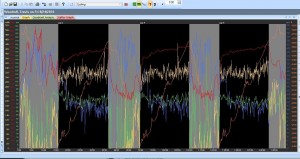This Q&A article was originally posted on MTBRaceNews.com.
Question: I want to be fast for some early season national races but I live in a cold climate. How do I get fast when it is still so cold outside?
Racing Fast After a Tough Winter
The early start to the national-level mountain bike season creates a tough situation for riders living and training in wintery locations. Despite numerous challenges that exist, it is completely possible to have successful early season performances. In recent years the national circuit has kicked off with March races hosted in Arizona or California while Sea Otter has remained a mid-April staple. To be in race-ready condition it typically takes several months of consistent training which means that training begins long before conditions are favorable.
I started my cycling career in Wisconsin and know firsthand how brutal the winter months can be when trying to ride consistently. Memories of countless hours spent on the trainer or facing sub-freezing temperatures on messy snow covered roadways have not left even though I’ve called Tucson, Arizona home during recent winters. Many of those who I coach still embrace their winters so I continue to strategize ways to make the most of each rider’s situation as it pertains to training for the early season. It’s important to note that embracing winter is much different than dealing with it, and it’s this pro-active mindset that is extremely beneficial when a rider must make the most of their circumstances.
Two Midwest riders have had some excellent early season races that stand out in recent memory. Jenna Rinehart (Mankato, MN) placed 9th in the 2009 Sea Otter XC and Mike Phillips (Milwaukee, WI) placed 9th in the 2008 Fountain Hills, AZ NMBS XC. These racers have certainly achieved other noteworthy results, but these finishes exemplify two successful winter training programs.
Set the goal and be motivated
It all starts with a lot of motivation. Only when a rider is inspired to excel, does fast racing become possible. Putting this motivation to work in the right direction is equally important. This is especially true when an athlete must work through less than desirable conditions in order to achieve their goal. With attention set on a goal, a focused athlete is more willing to do the required work than are their lesser-motivated counterparts. With high motivation it is possible to stick with a plan and embrace challenges as they come. Having a coach can help direct your efforts and a support system in place will help you keep everything on track.
When conditions are poor it’s wise not to squander training time, so a little extra organization and encouragement can certainly help. A few dedicated training partners will go a long ways to keep spirits high when the temperatures are low. Planning for early season success will allow you to achieve it.
Train hard (specifically)!
During weekdays when training time and daylight are most often limited, completing workouts that specifically address VO2Max or Lactate Threshold fitness are excellent options (indoors or out). A ride of 60-90 minutes can be highly effective this way. The ‘off season’ is an opportunity to improve by incorporating race-like intensity in your workouts. This is especially true when your training volume cannot be relatively high. With a training plan tailored to improve specific components of your race fitness during the weekdays, weekends can be dedicated to longer duration workouts. These longer workouts should be done outdoors and on the bike when possible. If riding outdoors isn’t an option you can supplement in xc skiing, snowshoeing, or just about any other aerobic winter sport.
As the races get nearer, more of your weekend training should be done on the bike, but earlier on it’s equally effective to do the snow sports instead. Starting with a couple of hours and gradually extending workouts longer each week as you adapt will allow for progression. Keep in mind that you’re doing very high quality riding during the week, so it’s okay for the weekend workouts to have less structure. As long as you’re building your aerobic endurance they’ll be doing the trick.
Keep it in perspective
Many riders adhere to the mantra that winter training needs to be low intensity training. While this might work for a rider who is able to accumulate a large training volume, it is certainly not the best option for a rider coming from a wintry environment. It is important to build intensity into the mix so that you’re always improving the components of your fitness that have the biggest impact on your racing results. In doing so, you’ll be specifically prepared for the speed and intensity of the early season races.
Training through a tough winter will never be easy, but neither is racing. With an early season goal and a lot of motivation it’s possible to show up ready to race fast despite the wintertime challenges. Just be sure to have fun with it and embrace the experience. For every one racer who trains successfully through a rough winter, there are a countless number who won’t find their form until later in the season. See what works best for you and always strive to find a healthy balance.

